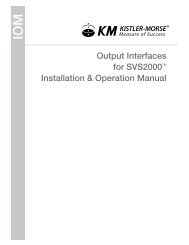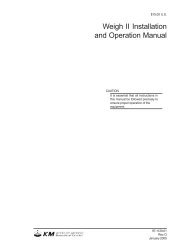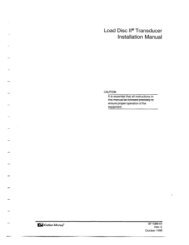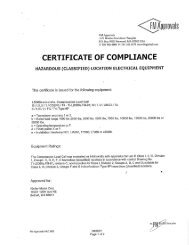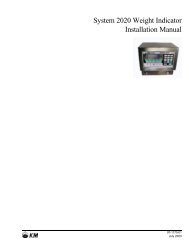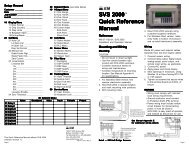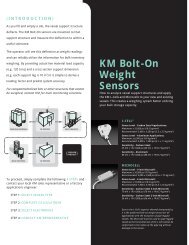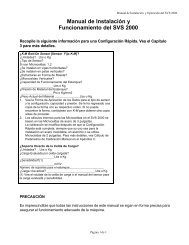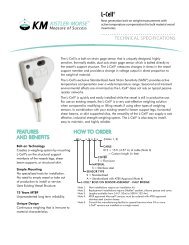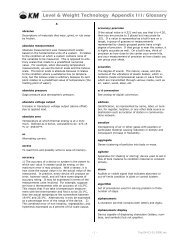STX Signal Transmitter Installation and Operation ... - Kistler-Morse
STX Signal Transmitter Installation and Operation ... - Kistler-Morse
STX Signal Transmitter Installation and Operation ... - Kistler-Morse
You also want an ePaper? Increase the reach of your titles
YUMPU automatically turns print PDFs into web optimized ePapers that Google loves.
○ ○ ○ ○ ○ ○ ○ ○ ○ ○ ○ ○ ○ ○ ○ ○ ○ ○<br />
○ ○ ○ ○ ○ ○ ○ ○ ○ ○ ○ ○ ○<br />
○ ○ ○ ○ ○ ○ ○ ○<br />
○ ○ ○<br />
Resetting Manual<br />
Calibration Parameters<br />
The third page of the Manual Cal Menu has a<br />
reset function. Use this menu to reset the<br />
calibration to the defaults, listed below:<br />
• Cnts/mV — dependent on Gain value<br />
(see Chapter 8, MVS-<strong>STX</strong> Service Menu).<br />
Value is 699.05 for the default Gain of 2.<br />
• 0mV cnts — 1,048,576<br />
• H_SPAN_W — 9,999*<br />
• L_SPAN_W — 0<br />
• H_SPAN_C — 1,298,576<br />
• L_SPAN_C — 1,048,576<br />
• ZERO_WGT — 0<br />
• ZERO_CNT — 1,048,576<br />
• SCF_WGT — 9,999*<br />
• SCF_CNT — 250,000<br />
*Decimal point/dummy zeroes are consistent<br />
with Form.<br />
Note<br />
Reset has no affect on analog scale<br />
factor counts <strong>and</strong> analog zero counts.<br />
Linear<br />
This function corrects nonlinearities from a<br />
vessel’s sensor output. Use of this function<br />
may be required if you notice one of the<br />
following after the system is correctly calibrated<br />
(using Auto Calibration):<br />
• The MVS gives accurate results when<br />
the live load is close to 0 <strong>and</strong> close to<br />
the full scale (maximum live load) value,<br />
but is consistently inaccurate between<br />
those values.<br />
• The MVS gives accurate results over<br />
some or most of the live load range, but<br />
is consistently inaccurate in one area.<br />
Chapter 7. MVS-<strong>STX</strong> Calibration Menu<br />
The word ‘consistent’ refers not only to an<br />
error occurring, but that the error is approximately<br />
the same each time. This type of error<br />
may be caused by a non-linear response of<br />
the vessel’s structure to changes in load.<br />
This type of error can also result from layering<br />
of multiple types of material in the vessel,<br />
with differing densities, in distinct,<br />
consistently defined layers.<br />
Note<br />
Changing the linearization table<br />
incorrectly can cause the MVS to<br />
display incorrect weight. Do not<br />
change the linearization table unless<br />
one of the above problems has<br />
been noted.<br />
The MVS’s linearization algorithm uses a fivepoint<br />
piece-wise linearization method with<br />
linear interpolation between points. Figure 7-4<br />
illustrates the linearization operation.<br />
Table 7-1 is the default linearization table,<br />
consisting of five raw digital count values as<br />
inputs <strong>and</strong> five corrected digital count values<br />
as outputs. The default for Linear is Off.<br />
Additionally, the raw <strong>and</strong> corrected default<br />
values are identical, so the default linearization<br />
table has no effect, even if linearization<br />
is On.<br />
Raw Value Corrected Value<br />
1048576 1048576<br />
1112576 1112576<br />
1176576 1176576<br />
1240576 1240576<br />
1304576 1304576<br />
Table 7-1. Default Linearization Table<br />
Consult with K-M to determine the values to<br />
input for linearization.<br />
Indicated<br />
Weight<br />
1R<br />
1C<br />
Linearized<br />
Output<br />
Non-Linear<br />
Input<br />
Counts<br />
2C 2R 3C 3R 4C 4R 5R<br />
5C<br />
Figure 7-4. Linearization Curve<br />
7-9<br />
Linearizing Table<br />
Raw Corrected<br />
Input Output<br />
1R<br />
1C<br />
2R<br />
2C<br />
3R<br />
3C<br />
4R<br />
4C<br />
5R<br />
5C<br />
Requirements of table values:<br />
1R



